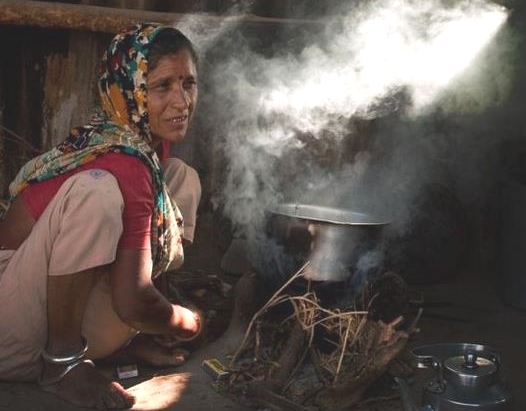Creative Minds: Harnessing Technologies to Study Air Pollution’s Health Risks
Posted on by Dr. Francis Collins
After college, Perry Hystad took a trip to India and, while touring several large cities, noticed the vast clouds of exhaust from vehicles, smoke from factories, and soot from biomass-burning cook stoves. As he watched the rapid urban expansion all around him, Hystad remembers thinking: What effect does breathing such pollution day in and day out have upon these people’s health?
This question stuck with Hystad, and he soon developed a profound interest in environmental health. In 2013, Hystad completed his Ph.D. in his native Canada, studying the environmental risk factors for lung cancer [1, 2, 3]. Now, with the support of an NIH Director’s Early Independence Award, Hystad has launched his own lab at Oregon State University, Corvallis, to investigate further the health impacts of air pollution, which one recent analysis indicates may contribute to as many as several million deaths worldwide each year [4].
Taking advantage of the latest scientific tools and technologies, Hystad is launching a study called PURE-AIR, which will monitor how outdoor and indoor air pollution affects the cardiopulmonary health of people living in low, middle, and high income nations. His goal is to quantify more precisely the global health impact of air pollution and to develop better ways of measuring health risks associated with poor air quality.
PURE-AIR will be part of the existing Prospective Urban and Rural Epidemiological (PURE) study, a global effort begun four years ago to track cardiovascular disease in 155,000 people in 17 countries for at least a decade. The type of pollutant that PURE-AIR will focus upon is fine particulate matter (PM2.5), which consists of airborne particles and droplets that measure less than 2.5 micrometers in diameter—30 times less than the width of a human hair. Fine particulate matter comes from a vast number of sources, most notably from the burning of fossil fuels, such as coal and oil; and biomass, such as wood, crop waste, and dried animal dung. These minute particles can be inhaled deeply into the lungs, where they can get trapped and trigger asthma attacks and other breathing problems. Because these particles can also carry carcinogenic compounds, inhaling fine particulate matter may increase the risk of cancer. The tiniest of these particles can even pass through the lungs and enter the bloodstream, with still largely undetermined consequences.

Caption: Indian woman using a indoor cookstove with limited ventilation.
Credit: Romana Manpreet, courtesy of Global Alliance for Clean Cookstoves
Interestingly, Hystad’s study would not have been possible just a few years ago, because technologies simply didn’t exist to estimate air pollution levels reliably around the globe. But, thanks to remote sensing data from satellites, it is now possible to determine PM2.5 air pollution levels anywhere on earth. Hystad, who is an assistant professor of environmental and occupational health, wants to obtain even more precise measures of exposure—so he is also collaborating with several private companies and universities to develop low-cost wearable sensors that can monitor accurately the air pollution exposures of thousands of individuals and households taking part in the PURE study.
Hystad hopes to couple these air pollution measurements with health assessments and lifestyle surveys of each participant. That will enable his team to search for possible links between poor air quality and heart attack, heart failure, stroke, adult-onset asthma, and a variety of lung problems, such as chronic obstructive pulmonary disease and cancer. To get things rolling, Hystad and his team plan to start collecting personal, household, and community air pollution measurements this summer in India, Bangladesh, and South Africa. Here’s wishing all of these creative minds safe travels—and success in their plans to provide some much-needed real world data on the health risks of air pollution.
References:
[1] Creating National Air Pollution Models for Population Exposure Surveillance in Canada. Hystad P, Setton E, Cervantes A, Poplawski K, Deschenes S, Brauer M, van Donkelaar A, Lamsal L, Martin R, Jerrett M, Demers P. Environ Health Perspect. 2011 Aug;119(8):1123-9.
[2] Spatiotemporal air pollution exposure assessment for a Canadian population-based lung cancer case-control study. Hystad P, Demers PA, Johnson KC, Brook J, van Donkelaar A, Lamsal L, Martin R, Brauer M. Environ Health. 2012 Apr 4;11:22.
[3] Long-term residential exposure to air pollution and lung cancer risk. Hystad P, Demers PA, Johnson KC, Carpiano RM, Brauer M. Epidemiology. 2013 Sep;24(5):762-72.
[4] A comparative risk assessment of burden of disease and injury attributable to 67 risk factors and risk factor clusters in 21 regions, 1990-2010: a systematic analysis for the Global Burden of Disease Study 2010. Lim SS, Vos T, Flaxman AD, et al. Lancet. 2012 Dec 15;380(9859):2224-2260.
Links:
Air Pollution (National Institute of Environmental Health Sciences/NIH)
Particulate Matter (Environmental Protection Agency)
Hystad Lab (Oregon State University, Corvallis)
PURE-AIR: A Global Assessment of Air Pollution and Cardiopulmonary Disease (RePORTER/NIH)
PURE – Prospective Urban and Rural Epidemiological Study
NIH Director’s Early Independence Award Program
NIH Support: Common Fund


This is great work. Could Perry Hystad also please measure mercury emissions in the air, and mercury levels in people downwind of exposure sources, which include coal fired power plants, artisanal gold mining, and crematoria which are exempt from strict pollution controls and do not removal amalgam fillings prior to cremation? I have often wondered if the high rates of mercury in San Francisco Bay are not just from the gold mining days, but from the crematorium in Emeryville.
Between California’s high-food-chain fish consumption of swordfish and tuna, and still prevalent use of dental amalgam fillings despite being one of only four states to warn consumers that they contain mercury and may be hazardous to health, people are best not to breathe in any more mercury vapor than from their own teeth directly.
In making final arrangements, I tried to get the stubs of my mother’s largely dissolved amalgam fillings removed before she was cremated, but could not. I was told I could have her ashes turned into a diamond or a piece of personal jewelry, but could not pay for this basic public health measure. I also tried to get a brain autopsy to measure how much mercury from the dissolved fillings due to high acid content in the mouth might have contributed to her horrible and steep decline at the end, but could not. It was the weekend.
It’s important that someone pays attention to such crucial matters like the one described above. I hope that effects of the studies would bring us some revolutionary conclusions about our health in the era of air pollution.